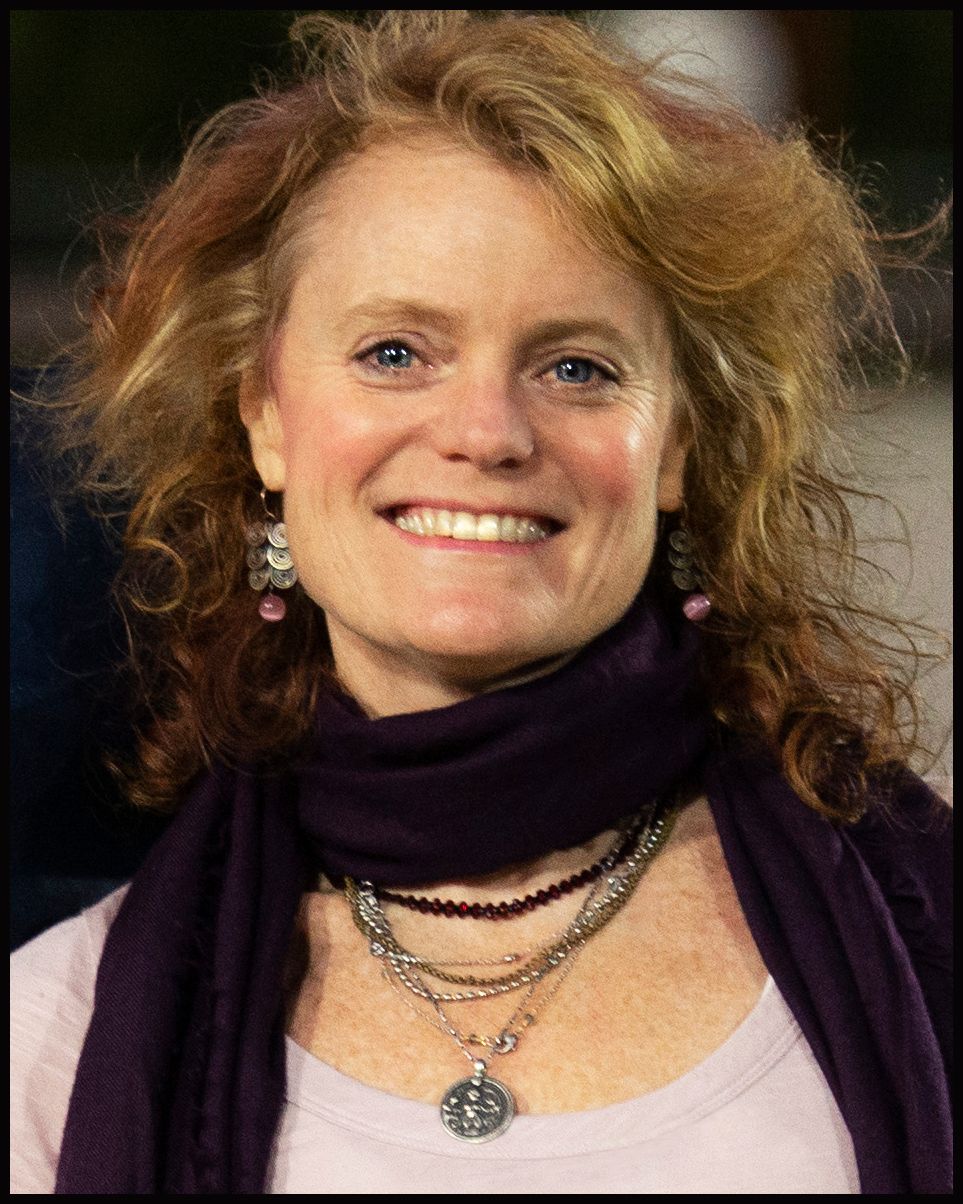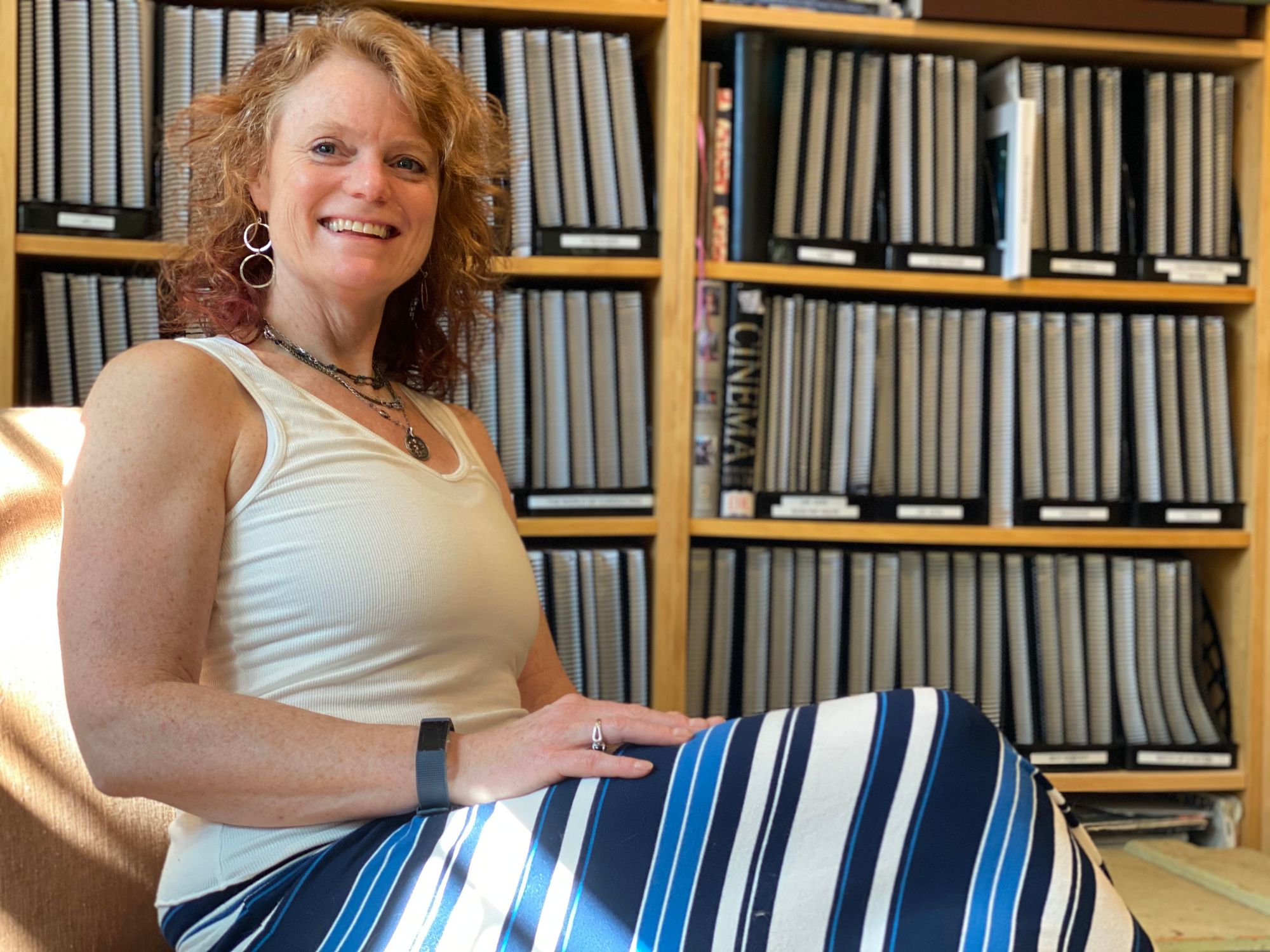Storyteller Behind the Scenes and Screen — Alumni Profile, Amy Stevens Hammond ’92
From the stage to the screen, Amy Stevens Hammond ’92 has found a home behind the scenes, working tirelessly to bring stories to life.


In the distant background of Amy Stevens Hammond ’92’s Zoom window, there’s a cat hobbling around stacks of books and piles of binders.
“Excuse my three-legged cat,” Stevens Hammond acknowledges sheepishly.
Stevens Hammond is Zooming from her basement, which has also served as her work office for the past 20 years. Sitting in her office chair, she is engulfed by systematized chaos. Several carefully balanced towers of books and notepads are grounded on a coffee table that has been repurposed as a shelf. She alerts me that what I can’t see in the Zoom frame is a floor-to-ceiling bookshelf that houses even more books and binders. From my vantage point, the three-legged cat is navigating this obstacle course with impressive dexterity.
The copious amount of reading material in Stevens Hammond’s basement office might lead to the assumption that she is some sort of archival historian, or maybe an author, or possibly an LJST professor. These guesses are all partially correct but ultimately incomplete. Stevens Hammond describes her job as something she “made up.”
“I’ve kind of done that a lot along the way, like figured out what I have decided is a hole [where she works] and put myself in it.”
Her official title is a film and television story researcher. The theater equivalent is a dramaturg — a role that Stevens Hammond knows well because she started in the theater world. Her job boils down to two central services. For directors and producers, she provides extraordinarily in-depth and comprehensive research to help develop the ideas and structure of a production’s plot — she calls this “world building.” Meanwhile, for actors, her encyclopedic research serves to help them more deeply understand and embody their characters — she calls this “character building.” Her months-long investigations take her to archives, court cases, and more — ultimately culminating in an organized, aesthetically pleasing production binder that looks like a textbook, specifically made for the production she’s working on. Stevens Hammond’s production credit list is full of household names: “Les Miserables,” “Call Me by Your Name,” and “The Music Man” on Broadway, to name a few. She has been publicly referenced by Hugh Jackman, Anne Hathaway, and Armie Hammer for her character development support.
In true Amherst fashion, Stevens Hammond’s career is the essence of interdisciplinarity — every day looks different, every project requires new skills, and because of that, she does not have a singular job description. But fundamentally, Stevens Hammond is a storyteller, an identity that has followed her through every turn of her path so far.
Thirteen Houses, One Home
Before Stevens Hammond had even entered high school, she had already lived in 13 different houses.
“We chased education, honestly,” Stevens Hammond recounts. “There’s some military families that move—no, we moved for schools.” When Amy was growing up, her parents were working toward college degrees. Their family relocations were thus largely determined by the colleges her parents were enrolled at. By the time she got to ninth grade, her family had settled in Milton, Mass. where she attended Milton Academy.
When Stevens Hammond recalls her time at Milton, the first memory she reflects on is theater.
“I’m a theater girl. I’ve been a theater girl forever,” she says. At Milton, the big student theater production was the ninth grade play, which Stevens Hammond stage managed. Though she has experience acting, Stevens Hammond has always preferred working behind the scenes and “making it happen.”
In fact, despite living in a multitude of places throughout her childhood, she has always found a home backstage. “It’s such a magical space, I have relationships with a number of theaters,” she says. “The space just takes on a kind of magic of its own.”
Falling in love with the scene behind the curtain meant that Stevens Hammond knew what she wanted to study when she went to college.
Telling Stories from Backstage
Upon arriving at Amherst, Stevens Hammond recalls, “I came in knowing I wanted to do theater, having done theater all my life.” And so she did, in full force.
As a Theater & Dance major at Amherst College, Stevens Hammond not only found ways to participate in Kirby Theater productions, but also those outside of campus. She spent summer and winter breaks working at theater festivals in Baltimore, Williamstown, and plenty of other regional centers. Throughout her college career, Stevens Hammond was thus “singularly focused” on telling stories through the stage.
It is uncommon to hear about an Amherst student who knew exactly what path she wanted to take as soon as she stepped foot on campus. Amherst’s Open Curriculum is known to self-select students to explore more before deciding on their path. But despite her atypical decisiveness, Stevens Hammond was just as eager to “take everything, and I did.” In addition to her major requirements, she loaded as many non-theater courses as she could.
She took “Physics for Poets,” classes in philosophy, English, Spanish, and more. In fact, one of Stevens Hammond’s biggest college regrets — and the advice she has for current Amherst students — is to take more classes in more departments: “I honestly wish I’d had more time…I would have taken more classes…Because just the chance to sit and read and engage with people reading and thinking is a gift.”
As she moved through her four years in the Pioneer Valley, Stevens Hammond realized that the degree of certainty that she entered campus with was not as durable as she had initially thought.
“I came in thinking at 18 that I knew what the path was…But I didn’t know as much as I thought I knew at 18. I’m sure I didn’t know as much as I thought I knew at 22 when I left, but I really knew a lot more.”
From Coast to Coast
Right out of college, Stevens Hammond ended up at Hartford Stage, a regional theater in Hartford, Conn., as a directing intern.
“I feel like Hartford Stage was my graduate school,” she says.
Stevens Hammond started as an intern but did not stay that way for long. In her first role, she managed to start a directing intern program to bring new people in, became a dramaturg (which she would later translate to her job in Hollywood), brainstormed future seasons of production for the theater, wrote the program notes, and led educational tours in Hartford’s public schools. Her work filled an evident need at Hartford Stage, so much so that she stayed for four years despite only being originally hired for an internship. “I created for myself at Hartford a job that hadn’t really previously existed, and [it] worked and brought them something.”
After leaving Hartford, Stevens Hammond entered what she recalls were “much more uncertain days.” She switched coasts, leaving Connecticut’s continental climate for Los Angeles’s year-round sun. Her first couple of stints at production companies in LA led her to work on projects like “Dante’s Peak” and at CW Productions, “Mission Impossible.”
But the grind of the production workday started to weigh on Stevens Hammond when she realized that the overload of work — being saddled with reading 30 scripts in one weekend, for example — meant that “there wasn’t any depth to the work. It was just too much too fast.” But when she expressed her desire to leave the company, “They were like, ‘No you’re not. Let’s figure out a different plan.’” And that’s exactly what she did.
“A Different Way Forward”

Stevens Hammond credits her boss and mentor at CW Productions, Paula Wagner, for helping her find “a different way forward for a female executive than what she [Wagner] had been allowed coming up.” Her new job structure allowed her to take on fewer projects for a more extended period of time, and get the work done to the depth she wanted — it also allowed her to start a family.
“Each of my projects takes months. I do a super deep dive into exactly what happened,” she explains. As she puts it, each of her projects is like writing a dissertation. In practice, that means that Stevens Hammond fills her days sifting through primary sources: court documents, psychology experiments, and anything else that seems relevant to the world or character that a film or TV show is trying to build. After her research phase, the storytelling begins. She lays out her production binders in software that a book or newspaper might use. It is during the design construction that she begins to put the narrative together. The final product is a “really big, beautiful bound presentation book.”
“It makes people happy — having it look good and being accessible and understandable … My books have table[s] of contents and dividers, they’re very structured and organized.”
Stevens Hammond stayed with CW Productions (which later became United Artists) for years until she realized, “You know what, I can do this.” “This” meant going out on her own to start a company as a story researcher. After knocking on enough doors, Stevens Hammond’s company, Heavy Water Productions, finally got off the ground.
What Comes Next?
Now that she has raised two kids, started her own company, and essentially carved out her own spot in Hollywood, Stevens Hammond is now looking to her next steps. She loves the world she lives in through her work and in many ways, does not want that to change. But she does note a desire to get even deeper into hands-on production, possibly shifting to more involved producer roles in the future.
Stevens Hammond has had her fair share of geographic relocations and career pivots throughout her life so far. Through every change, Stevens Hammond has found her way and adapted: “As a freelance worker, you are reactive. Those growth points have been when I’ve had to make a change.”
The twists and turns that define the life of a storyteller like Stevens Hammond could be likened to the three-legged cat’s basement obstacle course. And just like that cat, Stevens Hammond has been navigating it with impressive dexterity.





Comments ()